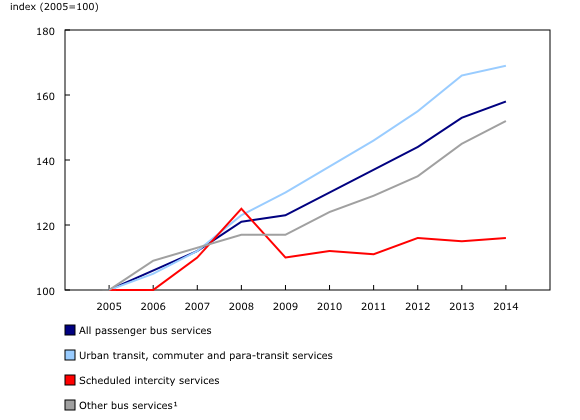Passenger bus and urban transit, 2014
Archived Content
Information identified as archived is provided for reference, research or recordkeeping purposes. It is not subject to the Government of Canada Web Standards and has not been altered or updated since it was archived. Please "contact us" to request a format other than those available.
Released: 2016-07-25
Total operating revenues for the Canadian passenger bus and urban transit industry declined 3.7% from 2013 to $11.4 billion in 2014, while total operating expenses increased 4.5% to almost $13.0 billion.
In 2014, human resources accounted for 57.3% of total operating expenses, with drivers and operators representing over two-thirds (68.0%) of full-time equivalent employees.
These employees operated almost 75,000 vehicles, including about 64,000 motor coaches, school buses and transit buses.
The industry consumed 968.8 million litres of diesel fuel and 816.1 million kilowatts of electricity to fuel this equipment. Vehicle energy expenses accounted for 9.5% of total operating expenses in 2014.
Urban transit the largest industry component
About 90 urban transit operators generated around two-thirds ($7.5 billion) of total operating revenue in Canada in 2014, with operators in Quebec and Ontario accounting for three-quarters of this revenue.
Most (54.4%) urban transit operating revenue was earned through passenger fares in 2014. However, the urban transit industry received 79 cents in operating subsidies for every dollar earned.
The other one-third ($3.9 billion) of total industry operating revenue in 2014 was generated by over 950 passenger bus companies operating in Canada.
Compared with 2013, operating revenue increased for school and employee bus (+7.1%), charter bus and sightseeing (+2.5%), and other transit and shuttle service (+3.3%) companies in 2014. Conversely, operating revenues earned by interurban and rural companies declined 1.7%.
Scheduled intercity service slowing
Over the last 10 years, revenue generated by all types of passenger bus and urban transit services has grown steadily, except revenue from scheduled intercity bus service, which has been relatively flat since the economic downturn of 2008.
In Canada, passengers travel mostly by private motor vehicle. According to the Travel Survey of Residents of Canada, just over 2% of domestic trips (more than 40 kilometres one way) made by Canadians were by passenger bus in 2014.
According to Transport Canada research, while passenger bus service represents the most extensive public transport network in Canada, it is characterized by a low and declining frequency of service, particularly outside of major service corridors.
Note to readers
The Annual Passenger Bus and Urban Transit Survey collects financial and operating information from companies operating in Canada.
The 2014 survey covers the following North American Industrial Classification System (NAICS) 2012 industries: urban transit systems (NAICS 485110), interurban and rural bus transportation (485210), school and employee bus transportation (485410), the charter bus industry (485510), other transit and ground passenger transportation (485990), and scenic and sightseeing transportation (487110).
Classification of establishments into these various industries is based on revenue earned by type of service. For example, an establishment that earns most of its operating revenue from scheduled intercity service is classified to the interurban and rural bus transportation industry. However, this same establishment may also earn some revenue from charter or sightseeing services or from other sources, such as package delivery service.
As part of Statistics Canada's Integrated Business Statistics Program, changes were made to the survey program for the 2014 reference year. While most content remained the same, some collection and processing methods changed, which could affect comparability of estimates with those for years prior to 2014. For example, estimates now cover the whole population rather than the top 95% of companies. Also, urban transit, commuter services and para-transit services were combined into one category.
Following a quality review, CANSIM table 408-0011 has been discontinued temporarily. CANSIM tables 408-0009 and 408-0012 will be released at a later date.
For more information on these changes, consult the methodology document, Annual Passenger Bus and Urban Transit Survey.
Contact information
For more information, or to enquire about the concepts, methods or data quality of this release, contact us (toll-free 1-800-263-1136; 514-283-8300; STATCAN.infostats-infostats.STATCAN@canada.ca) or Media Relations (613-951-4636; STATCAN.mediahotline-ligneinfomedias.STATCAN@canada.ca).
- Date modified:


